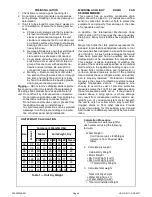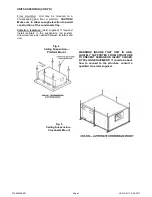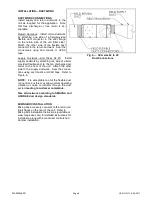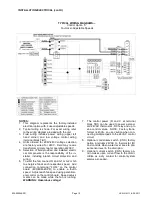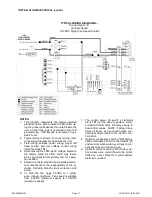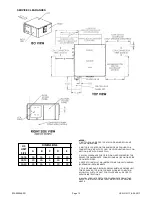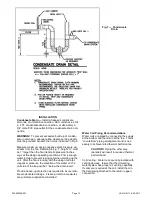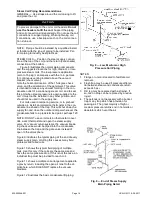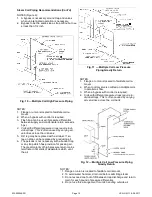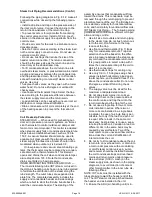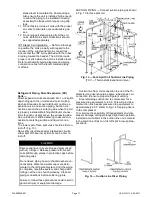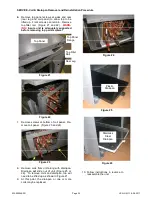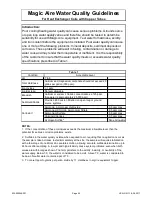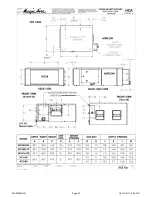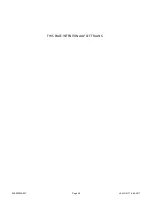
035-000049-001
Page 19
HCA IOM 1.1 8-28-2017
START-UP
Pre-Startup
BUILDING ENVELOPE
—
All building windows and
doors should be installed and closed before starting
unit. During summer construction, avoid unit sweating
by allowing for gradual pull down: use elevated chilled
water temperature, reduce chilled water flow rate
(gpm), use maximum available airflow.
HEATING FLUID TEMPERATURE-Maximum entering
water temperature is 180°F, unless nameplate indicates
200°F.
CAUTION
: If unit is marked for 200°F maxi-
mum entering water temperature, customer must en-
sure that water vaporization does not occur especially
at higher elevations when entering water temperatures
are greater than 190°F.
TEMPERATURE CONTROLS-Check that unit or wall
mounted thermostat or field-supplied controller is con-
nected to the unit.
OUTSIDE AIR AND FREEZE PROTECTION-
WARNING: Insure that the unit is protected against
freezing conditions Failure to provide freeze pro-
tection may result in equipment or property dam-
age.
Freeze protection measures are customer-
provided and installed and include but are not limited to
low-limit thermostats, automatic temperature controls,
and use of glycol based heat transfer fluids (see section
FREEZE PROTECTION OF WATER PIPING).
1. If “locking quadrant” manual damper operator pro-
vided, set to desired position.
2. If damper actuator provided, insure that actuator
opens the damper when the fan turns on, and closes
when fan stops. Test mixing box controls to make sure
OA damper closes on power failure or upon activation
of customer-supplied and installed low limit thermostat
or other freeze protection device.
Start-Up Check List —
Remove all construction debris
from unit interior.
Remove tools and all foreign objects
before starting unit. Checklist—perform full startup
checklist located on the last page of this manual, and
submit to the factory to register the warranty.
FILTERS — Install unit filters in all filter sections. Pro-
tect open filters from drywall dust and construction de-
bris.
MOTOR/FAN ASSEMBLY
1. Hand turn fan to make certain it turns freely and fan
wheel does not rub the inlet ring.
2. Check fan speed with a laser-type tachometer to
confirm operating speed (access doors must be
closed to apply correct external static pressure to
the fan).
3. Check direction of rotation (see Fig. 15).
4. Check vibration. If excessive vibration occurs,
check for the following:
A. Shipping screws removed.
B. Inadequate airflow.
C. Damaged wheel.
D. Loose mounting bolts.
E. Wheel or motor out of balance.
F. External vibration isolators improperly ad-
justed.
G. Out-of-balance or corroded wheel
(rebalance or replace if necessary).
H. Accumulation of material on wheel (remove
excess material).
Fig. 15 — Fan Wheel Rotation
COILS
1. Make sure freeze protection measures are
in place to protect water coils from freezing
(see section FREEZE PROTECTION OF
WATER PIPING).
2. Make sure hydronic (water based chllled
water and hot water) systems are filled and
have air removal devices in operation.
3. For hydronic coils with 3ea connections,
make sure that the supply connection is at
the bottom (air leaving side of coil) and re-
turn connection is in the middle (air entering
side of coil), and the top connection is
capped with the factory-provided cap.
Start-Up—Run Fan, Set Airflows
CONTROLS
Set up control system so that it correctly runs
the fan as needed and activates control valves
when required. Note that operating cooling with
the fan off can cause the cabinet temperature to
become too low and result in condensation in-
side and outside the unit cabinet, leading to un-
safe conditions. When fan is not running, cool-
ing should be inactive.
START THE FAN
With 4-Speed Control:
1. Using a thermostat: Route R, C and G1
connections in the HCA control box to the
matching thermostat connections (include
G2 and G3 if required). Set thermostat to
run the fan at speed G1.
2. Without a thermostat: Jump together the R
and G1 terminals in the control box.
3. While fan is running, adjust potentiometer
marked “FLO1” that controls fan speed G1
using a small flat blade screwdriver. Repeat
for the other speeds as needed.
With 0-10VDC Control:
1. Using a thermostat: Route R, C, + (plus)
and -(minus) connections in the HCA control
box to the matching thermostat connections.
Set the thermostat to run the fan.
2. Without a thermostat: Provide a DC control
voltage across the + (plus) and — (minus)
terminals.
3. Fan starts at 2.0VDC. Fan speed varies
across available range (pre-programmed at
factory) from 2.0 VDC (minimum speed) to
10.0 VDC (maximum speed).
Summary of Contents for HCA Series
Page 2: ...035 000049 001 Page 2 HCA IOM 1 1 8 28 2017 THIS PAGE INTENTIONALLY LEFT BLANK...
Page 26: ...035 000049 001 Page 26 HCA IOM 1 1 8 28 2017...
Page 28: ...035 000049 001 Page 28 HCA IOM 1 1 8 28 2017 THIS PAGE INTENTIONALLY LEFT BLANK...
Page 29: ...035 000049 001 Page 29 HCA IOM 1 1 8 28 2017 THIS PAGE INTENTIONALLY LEFT BLANK...

